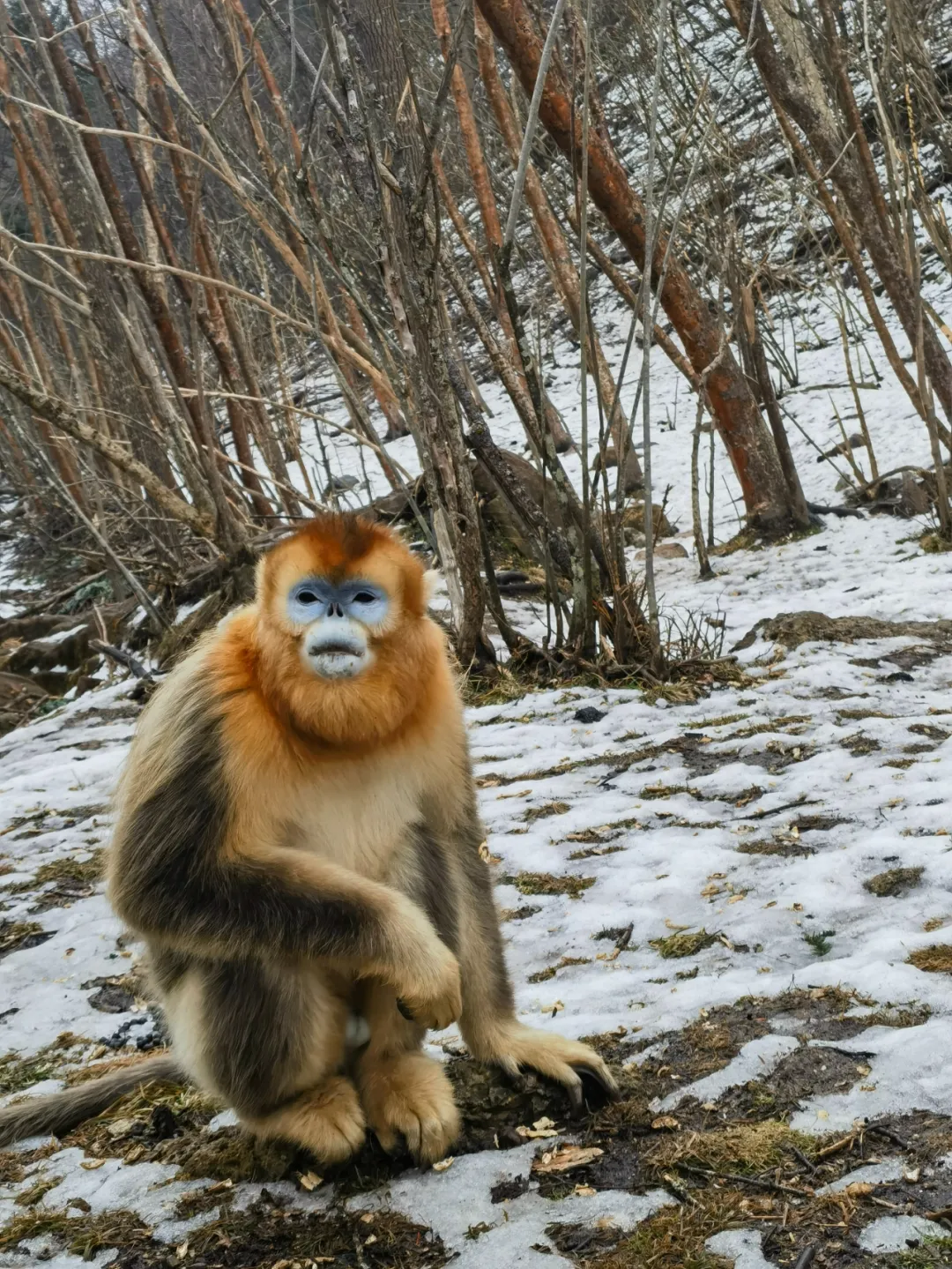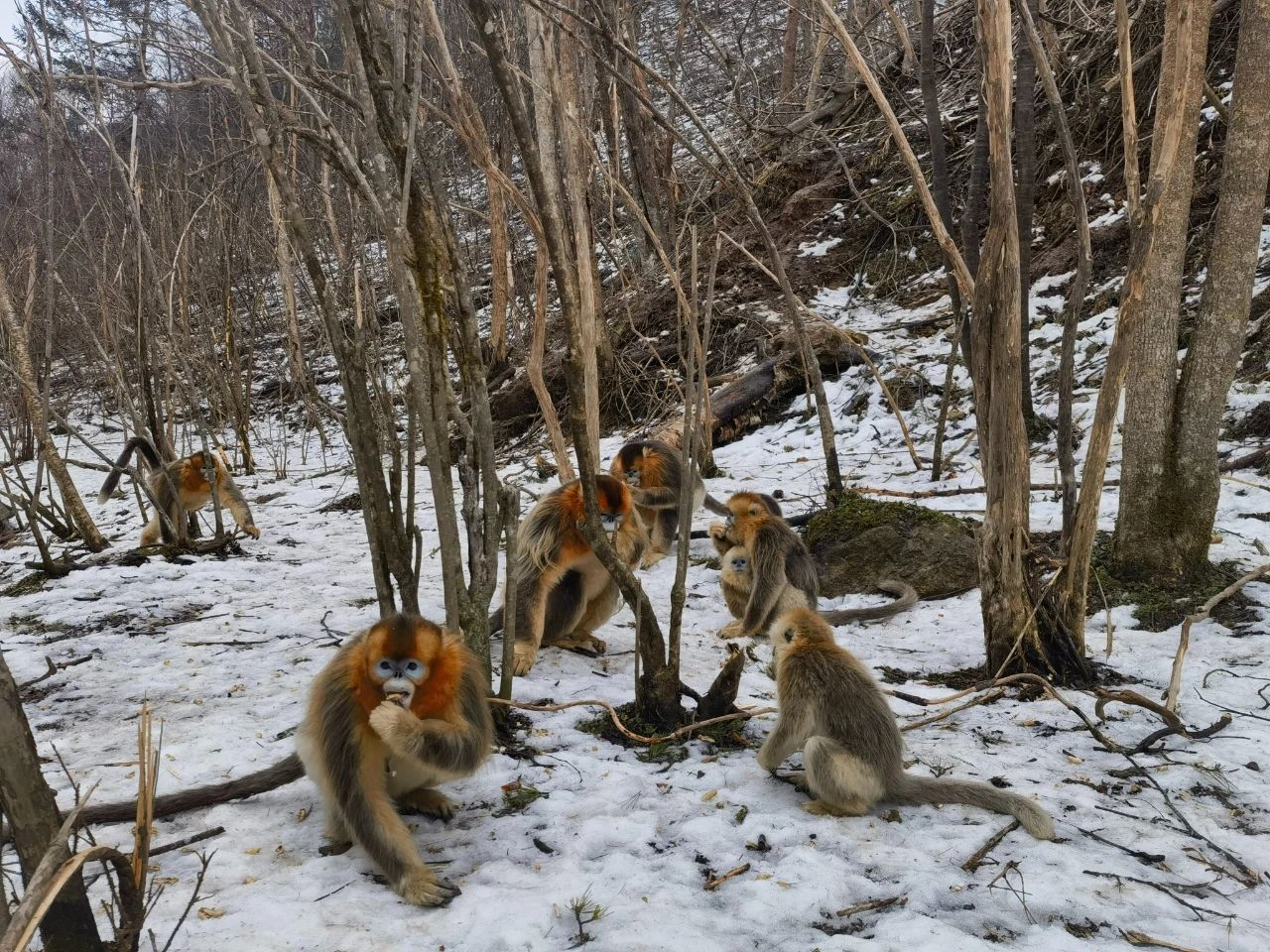Did the Monkey Get "A New Name"?
Updated:2024-07-03 Source:People's Daily Online Hubei Channel
31°N Latitude
In the mysterious primeval forest of Shennongjia in Hubei
there resides a group of "golden elves"
known as the golden snub-nosed monkeys
 △Golden snub-nosed monkeys in the snow at Shennongjia. Photo by Zhou Wen, People’s Daily Online
△Golden snub-nosed monkeys in the snow at Shennongjia. Photo by Zhou Wen, People’s Daily OnlineOn June 29, the government of Shennongjia Forestry District in Hubei held a press conference to announce the findings of the "Shennongjia Golden Snub-nosed Monkey Population Survey"
The golden snub-nosed monkeys living in Shennongjia will officially be named "Shennongjia Golden Snub-nosed Monkeys" and will be managed and protected as an independent management unit.
What were the Shennongjia Golden Snub-nosed Monkeys called before?
Li Ming, a researcher at the Institute of Zoology, Chinese Academy of Sciences, explained that Shennongjia is the easternmost region of the world's golden snub-nosed monkey distribution and is the only global distribution area of the Hubei subspecies of the Sichuan golden snub-nosed monkey, known as the Shennongjia Golden Snub-nosed Monkey. This population is the smallest and most endangered, representing a typical isolated "small population".
Therefore, before getting "a new name", their official name should have been the "Hubei subspecies of the Sichuan Golden Snub-nosed Monkey" or "Shennongjia Sichuan Golden Snub-nosed Monkey".
Why it has to get a new name?
According to Li Ming, "There are significant differences between the Shennongjia group of the Hubei subspecies of the Sichuan Golden Snub-nosed Monkey and other golden snub-nosed monkey populations."
Compared to non-Shennongjia populations, the Shennongjia golden snub-nosed monkeys exhibit distinct morphological differences such as the absence of nasal bones, fusion of the premaxilla with the upper lip notch, longer tails almost 125% of the head and body length, longer forelimbs, and a pale golden-red back.
 △Golden snub-nosed monkeys in the snow at Shennongjia. Photo by Zhou Wen, People’s Daily Online
△Golden snub-nosed monkeys in the snow at Shennongjia. Photo by Zhou Wen, People’s Daily OnlineThe Shennongjia population has significant genetic differentiation from non-Shennongjia populations, although there is still some gene flow among non-Shennongjia populations. The Shennongjia population also shows positive selection signals in genes related to organ and morphological development, indicating different adaptability compared to other populations.
Due to human activities and future climate changes, the Shennongjia golden snub-nosed monkeys exhibit greater ecological and genomic vulnerability than other populations, requiring more attention in future conservation planning.
Additionally, Li Ming mentioned that the Shennongjia population also shows significant differences in evolutionary history and genetic diversity, "We believe they can be protected and managed as an independent management unit."
 △Golden snub-nosed monkeys in the snow at Shennongjia. Photo by Zhou Wen, People’s Daily Online
△Golden snub-nosed monkeys in the snow at Shennongjia. Photo by Zhou Wen, People’s Daily OnlineShennongjia Forestry District has carried out three surveys on golden snub-nosed monkeys distributed in Shennongjia in 1990, 2005 and 2019. The surveys show that in 1990, Shennongjia had five groups of golden snub-nosed monkeys, totaling 501 individuals, with a habitat area of 164 square kilometers. By 2005, this increased to eight groups and 1,282 individuals, covering 189 square kilometers. In 2019, the numbers were 10 groups and 1,471 individuals, with a habitat area of 354 square kilometers.
According to Feng Wei, Secretary of the Party Committee of Shennongjia Forestry District, and Secretary of the Party Committee of Shennongjia National Park Administration, the District has launched the fourth comprehensive survey of the population and distribution of golden snub-nosed monkeys. The survey team, composed of more than 40 researchers, carried out investigations and laboratory analysis in Shennongjia for more than two months. During the survey, a total of 840 person-trips were made for the fieldwork, covering 240 survey routes and 58,800 kilometers.
The findings indicate that since 2019, there has been an increase of one group, 147 individuals, and 47 square kilometers of habitat area. Compared to 1990, this represents an increase of six groups (83%), 1,117 individuals (223%), and 237 square kilometers of habitat area (145%). The survey data suggests that the population and number of golden snub-nosed monkeys in Shennongjia have been steadily increasing, and the habitat area has been continuously expanding, showing a sustained growth trend.
This survey has resulted in a unanimous recommendation from the academic community that the golden snub-nosed monkey be renamed the Shennongjia Golden Snub-nosed Monkey.
How to protect?
The golden snub-nosed monkey, as an endangered primate species endemic to China, is also the flagship species of Shennongjia's biodiversity conservation.
According to Yang Jingyuan, Director of the Scientific Research Institute at Shennongjia National Park Administration, in terms of species protection, every effort has been made to preserve the golden snub-nosed monkey's home by establishing a golden snub-nosed monkey protection system, innovatively setting up a golden snub-nosed monkey sanctuary alliance, repairing the damaged homes of golden snub-nosed monkeys and establishing a harmonious community for golden snub-nosed monkeys; in terms of scientific research, research platforms such as the "State Forestry Administration Golden Monkey Research Center (Shennongjia)" and the "Hubei Provincial Key Laboratory for Golden Monkey Conservation Research" have been established, producing a number of influential and original research results. They revealed the unique taxonomic status of the golden snub-nosed monkeys in Shennongjia and recognized their community structure characteristics for the first time.
Source: People's Daily Online Hubei Channel Zhou Tian, Yu Ling Editor: Zhu Zouzhou Executive Editor: Rong Xianming Copyright Shennongjia National Park
Address:36 Chulin Road, Muyu Town, Shennongjia Forestry District, Hubei Province 鄂ICP备18005077号-3
Address:36 Chulin Road, Muyu Town, Shennongjia Forestry District, Hubei Province 鄂ICP备18005077号-3
Email:2673990569@qq.com
Phone:0719-3453368
Phone:0719-3453368


TOP

